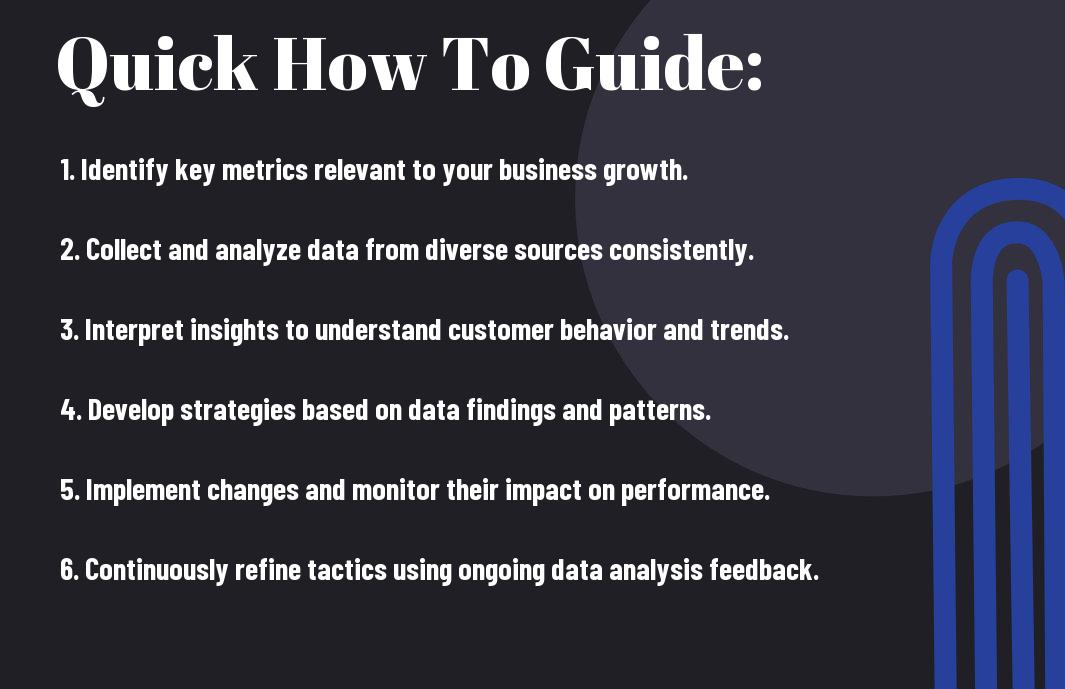
This guide will assist you in harnessing the power of data-driven insights to accelerate your business growth. You’ll discover how to collect, analyze, and implement information that can drive key decisions and optimize your strategies. By leveraging these insights effectively, you can enhance customer experiences, fine-tune your offerings, and ultimately increase your bottom line. Let’s launch on a journey to transform your business using actionable data today.

Understanding Data-Driven Insights
The world of business is rapidly evolving, and understanding data-driven insights is important for growth and innovation. These insights enable you to analyze patterns, trends, and behaviors within your market, providing you with valuable information to make informed decisions. By harnessing the power of data, you can refine your strategies, improve customer experiences, and ultimately drive your business forward.
What are Data-Driven Insights?
On a fundamental level, data-driven insights refer to conclusions derived from analyzing quantitative and qualitative data. These insights are generated through various methods, including statistical analysis, market research, and customer feedback. By utilizing this data, you can uncover valuable information about your customers, the effectiveness of your marketing efforts, and the overall health of your business.
Importance of Data-Driven Decision Making
Little can be accomplished without informed decision-making in today’s competitive landscape. Data-driven decision-making empowers you to make choices based on empirical evidence rather than intuition. When you rely on concrete data, you can significantly reduce risks, enhance operational efficiency, and optimize your resource allocation.
Data-driven insights facilitate a deeper understanding of your market dynamics and customer preferences, allowing you to craft tailored solutions. When you base your decisions on solid data, you can identify opportunities for growth and gain a competitive edge. Additionally, this approach fosters a culture of accountability within your organization, as decisions are supported by measurable outcomes rather than guesswork.
How to Collect Relevant Data
Clearly, collecting relevant data is crucial for making informed decisions that can drive the growth of your business. Begin by identifying the type of information that will help you understand your customers better, assess your market position, and evaluate the effectiveness of your strategies. Use both qualitative and quantitative data sources to ensure a comprehensive view of your business landscape.
Identifying Key Metrics
On your journey to leveraging data effectively, identifying key metrics is fundamental. Focus on the indicators that directly align with your business goals, such as customer acquisition cost, retention rates, and sales growth. This targeted approach allows you to measure performance accurately and make data-driven adjustments as needed.
Tools and Techniques for Data Collection
On the practical side, you can enhance your data collection process using various tools and techniques. Consider utilizing customer relationship management (CRM) systems, online surveys, and social media analytics to gather insights. Each method provides valuable data that can contribute to improving your business strategies.
Relevant tools for data collection range from simple analytics software to advanced platforms that integrate multiple data sources. Utilizing options like Google Analytics can help track website interactions, while survey tools like SurveyMonkey allow you to gather direct feedback. Experiment with these tools based on your specific needs to effectively capture data that supports your growth initiatives.
Analyzing Data for Actionable Insights
Many businesses overlook the power of data analysis in driving growth. By effectively analyzing your data, you can uncover patterns and trends that lead to actionable insights. This process involves examining your sales figures, customer feedback, and market dynamics to develop strategies that align with your business goals. Utilizing data insights can refine your decision-making process, enhance customer experiences, and ultimately drive growth.
Methods of Data Analysis
Analysis of data can take various forms, each suited to different objectives. Techniques like descriptive analytics summarize past performance, while predictive analytics forecast future trends. You may also consider prescriptive analytics, which recommends actions based on data-driven models. Utilizing tools such as spreadsheets, business intelligence software, and statistical programs can simplify the analysis process, helping you glean valuable insights from your data.
Interpreting Data Results
Clearly interpreting data results is vital in extracting meaningful insights. It involves understanding the implications of the data and how it correlates with your business objectives. You should analyze trends in customer behavior, sales performance, and operational efficiency to inform strategies that promote growth. Proper interpretation allows you to identify areas for improvement and capitalize on emerging opportunities.
Interpreting data results effectively enables you to translate numbers into a language that informs your business decisions. It involves grasping not just what the data shows, but also why it matters. By contextualizing data within your market and operational framework, you can draw connections that support actionable strategies. This understanding equips you to adjust your tactics and optimize performance based on solid evidence, paving the way for informed growth initiatives.
Implementing Data Insights in Business Strategy
Keep your business adaptable by integrating data-driven insights into your strategic planning process. This involves analyzing patterns and trends to inform decisions that align with your overall objectives. Successfully leveraging the power of data will help you to streamline operations, identify growth opportunities, and enhance your customer experience.
Aligning Insights with Business Goals
Now is the time to ensure that your data insights directly support your business goals. Evaluate your primary objectives and prioritize insights that drive revenue, enhance productivity, or improve customer satisfaction. By aligning your insights with these goals, you can create a more focused approach that maximizes impact and sets your business on a path to sustained success.
Adapting Strategies Based on Findings
If your data reveals new trends or unexpected results, be prepared to adapt your strategies accordingly. Utilizing these findings allows you to pivot your approach, ensuring that your business remains relevant and competitive in a rapidly changing market.
Findings from your data analysis can offer valuable information that shapes your strategic direction. By actively monitoring performance metrics, you can identify areas needing improvement or potential avenues for growth. Implementing a responsive strategy helps you stay ahead of market demands, allowing you to quickly capitalize on emerging opportunities or mitigate potential risks. Embracing a flexible approach to adapt your business strategies based on data insights is vital for long-term success.
Tips for Continuous Improvement
Unlike static strategies, embracing a culture of continuous improvement allows your business to adapt and thrive. To empower your growth journey, consider these tips:
- Establish regular review sessions to assess outcomes.
- Embrace agility in your operations to facilitate quick changes.
- Encourage team input for a diverse perspective.
- Set measurable goals for clearer insights.
This iterative process ensures you remain responsive to market dynamics and customer needs.
Monitoring and Adjusting Strategies
Improvement involves consistently monitoring your analytics to gauge the effectiveness of your strategies. Regular assessments allow you to identify trends, uncover potential issues, and allocate resources where they are needed most. By staying proactive, you can refine your approach for better performance and ensure your business stays competitive.
Leveraging Feedback Loops
If you’re not incorporating feedback loops, your growth may be stunted. Actively seeking input from customers and employees helps you to identify areas for enhancement. This feedback can lead to necessary modifications, ensuring your offerings align with expectations and demands.
Adjusting your business strategies based on feedback can lead to significant improvements in performance and customer satisfaction. By creating systems for gathering insights, you enable real-time responses to changing needs. Implementing structured feedback mechanisms, such as surveys or focus groups, allows you to refine your products and services continually, ensuring they remain relevant and competitive in the marketplace.
Factors Influencing Data-Driven Success
Now that you understand the importance of leveraging data, it’s crucial to recognize the various factors that contribute to your success in becoming a data-driven organization. Consider the following elements:
- Leadership Support
- Employee Engagement
- Data Quality
- Effective Communication
Any shortcomings in these areas can hinder your efforts to transition fully into a data-driven business.
Company Culture and Data Literacy
Factors that shape your company culture will significantly influence how well your team adapts to data-driven practices. Fostering a culture that emphasizes curiosity and value in analytics will encourage employees to embrace data-driven decision-making, improving overall performance.
Technology and Infrastructure Considerations
While implementing a data-driven strategy, you need to evaluate your technology and infrastructure. Proper tools enable efficient data collection, storage, and analysis, which are vital for gaining meaningful insights.
It’s crucial to invest in robust software solutions that integrate seamlessly with your existing systems. Scalability should also be a priority; as your data needs grow, your platform must be capable of handling increased demand. By ensuring you have the right tools and infrastructure in place, you set the stage for effective data utilization, ultimately enhancing your decision-making processes.
Summing up
Considering all points, leveraging data-driven insights can significantly enhance your business growth. By analyzing customer behavior, market trends, and operational efficiencies, you can make informed decisions that lead to improved strategies and enhanced customer engagement. Implement actionable analytics, continuously monitor your performance metrics, and adapt based on the insights gained. This proactive approach enables you to stay ahead of the competition and fulfill your business objectives more effectively. Ultimately, using data as a foundation for your strategies will empower you to unlock new opportunities for sustainable success.
Leave a Reply